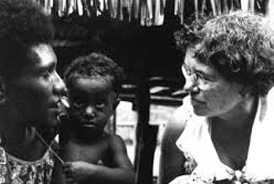by Sociologists At Work: The famous anthropologist Margaret Mead believed that masculine and feminine characteristics are based mostly on cultural conditioning.1 In the 1930s, she set out to support her theory by studying three cultures in New Guinea.
 Among the mountain-dwelling Arapesh, men and women displayed similar attitudes and actions. They showed traits we would commonly associate with femininity: cooperation, passivity, sensitivity to others. Mead described both men and women as being maternal. These characteristics were linked to broader cultural beliefs about people’s relationship to the environment. The Arapesh didn’t have any conception of ownership of land, so they never had conflicts over possession of property.
Among the mountain-dwelling Arapesh, men and women displayed similar attitudes and actions. They showed traits we would commonly associate with femininity: cooperation, passivity, sensitivity to others. Mead described both men and women as being maternal. These characteristics were linked to broader cultural beliefs about people’s relationship to the environment. The Arapesh didn’t have any conception of ownership of land, so they never had conflicts over possession of property.
South of the Arapesh were the Mundugumor, a group of cannibals and headhunters. Here, too, males and females were similar. However, both displayed traits that we in the West would associate with masculinity: assertiveness, emotional inexpressiveness, insensitivity to others. Mundugumor women, according to Mead, were just as violent, just as aggressive, and just as jealous as the men. Both were equally virile, without any of the soft characteristics we associate with femininity.
Finally, although the Tchambuli did distinguish between male and female traits, their gender expectations were the opposite of what we expect in modern societies. Tchambuli women were dominant, shrewd, assertive, and managerial; Tchambuli men were submissive and emotional and were seen as inherently delicate.
Mead’s work is important because it shows that definitions of the natural tendencies of men and women vary from culture to culture. Women need not be the nurturers of children; men need not be the aggressors. In the cultures that Mead studied, both women and men engaged in behaviors different from those typical in Western cultures yet were still considered women and men.









































